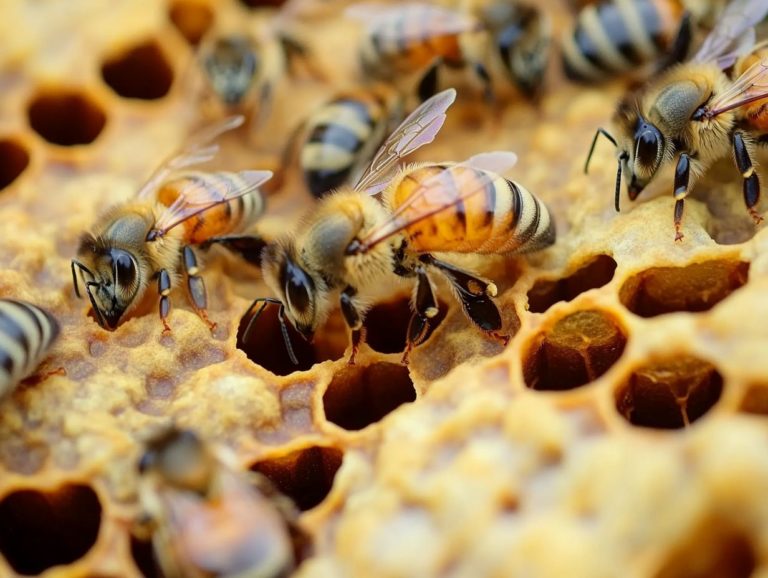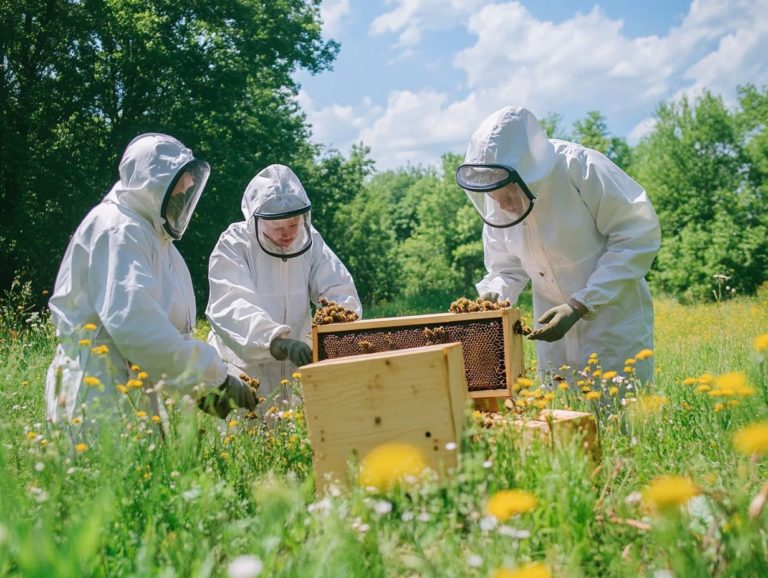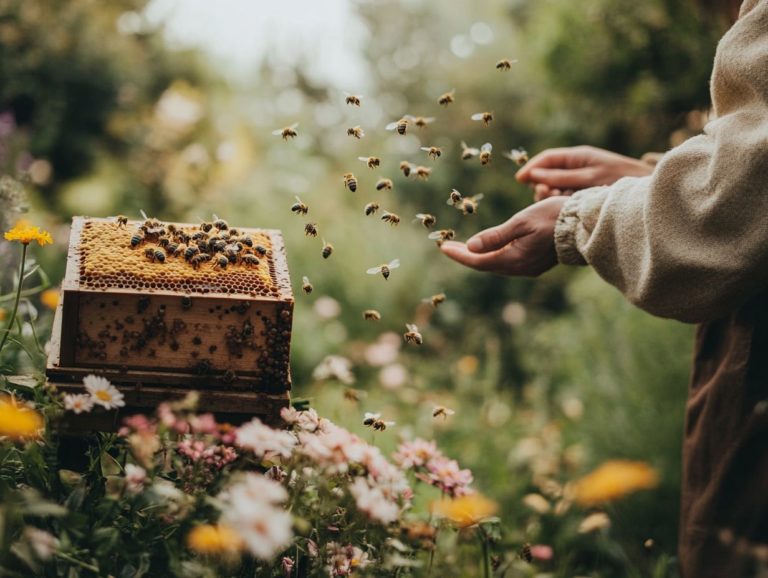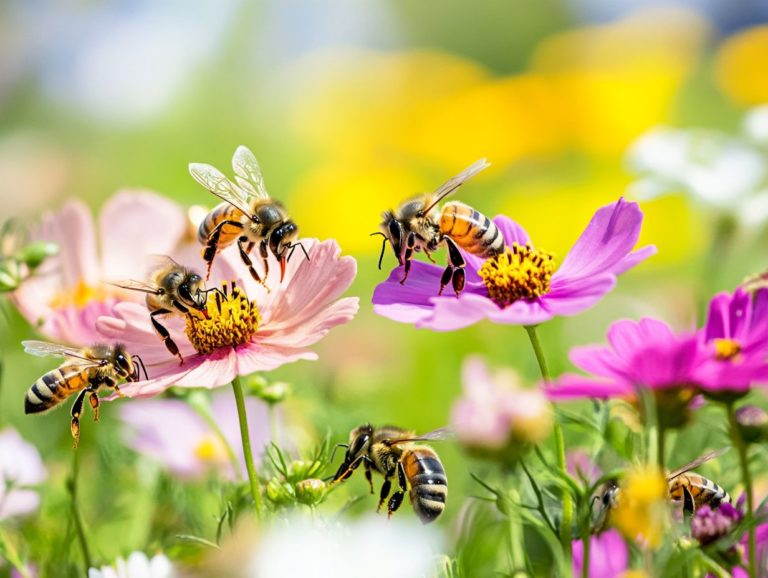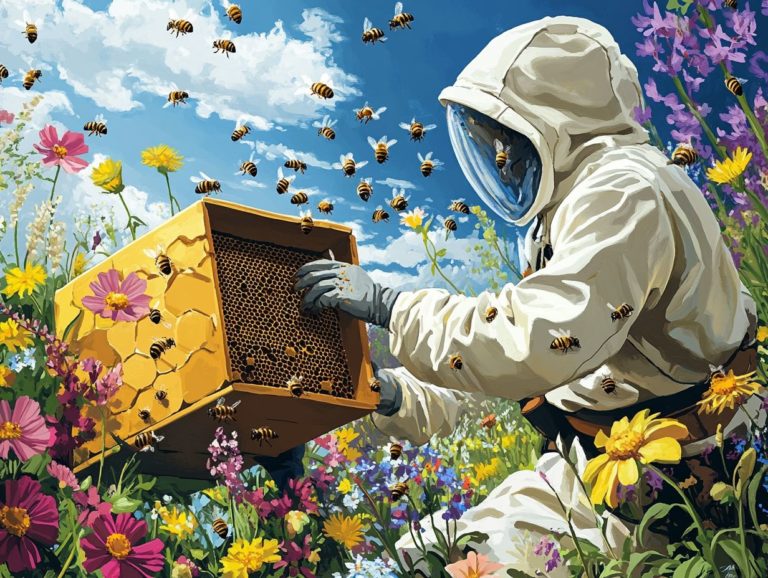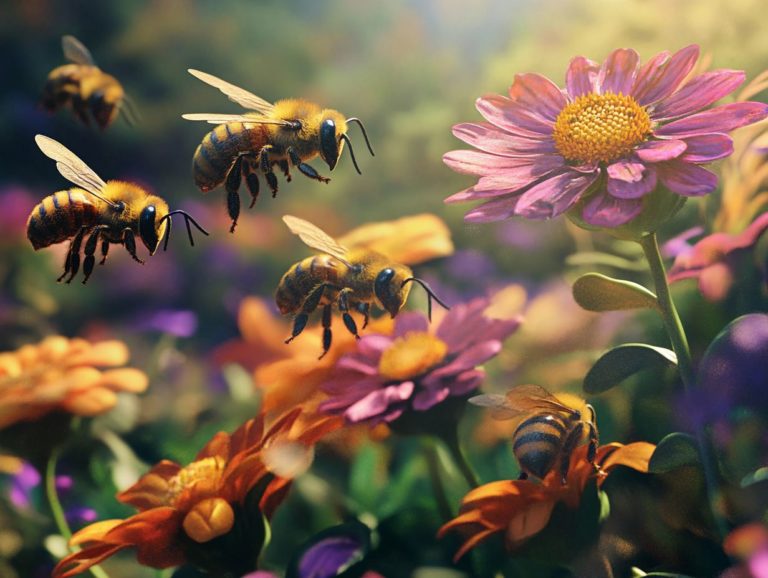How to Create a Diverse Hive Environment
Creating a thriving hive environment is crucial for the health and productivity of your bees. A diverse ecosystem not only supports their populations but also enhances their foraging abilities, honey production, and overall pollination efficiency.
This discussion delves into the significance of a varied hive environment, illuminating its benefits and the factors that contribute to its richness. You will find practical tips on nurturing this diversity, as well as signs that indicate a healthy hive. For local beekeepers, these insights can greatly enhance their practices.
Uncover the ways you can cultivate a vibrant environment for your bees by integrating native plants and bee-friendly flowers into your garden! Explore natural alternatives to pesticides to protect your hive!
Contents
- Key Takeaways:
- Why is a Diverse Hive Environment Important?
- What Factors Contribute to a Diverse Hive Environment?
- 4. Hive Location and Placement
- How to Create a Diverse Hive Environment?
- What Are the Signs of a Healthy and Diverse Hive Environment?
- Frequently Asked Questions
- What is a diverse hive environment and its benefits?
- Why is creating a diverse hive environment important?
- How can I create a diverse hive environment?
- What are some benefits of a diverse hive environment?
- Are there any challenges to creating a diverse hive environment?
- What are some tips for maintaining a diverse hive environment?
Key Takeaways:
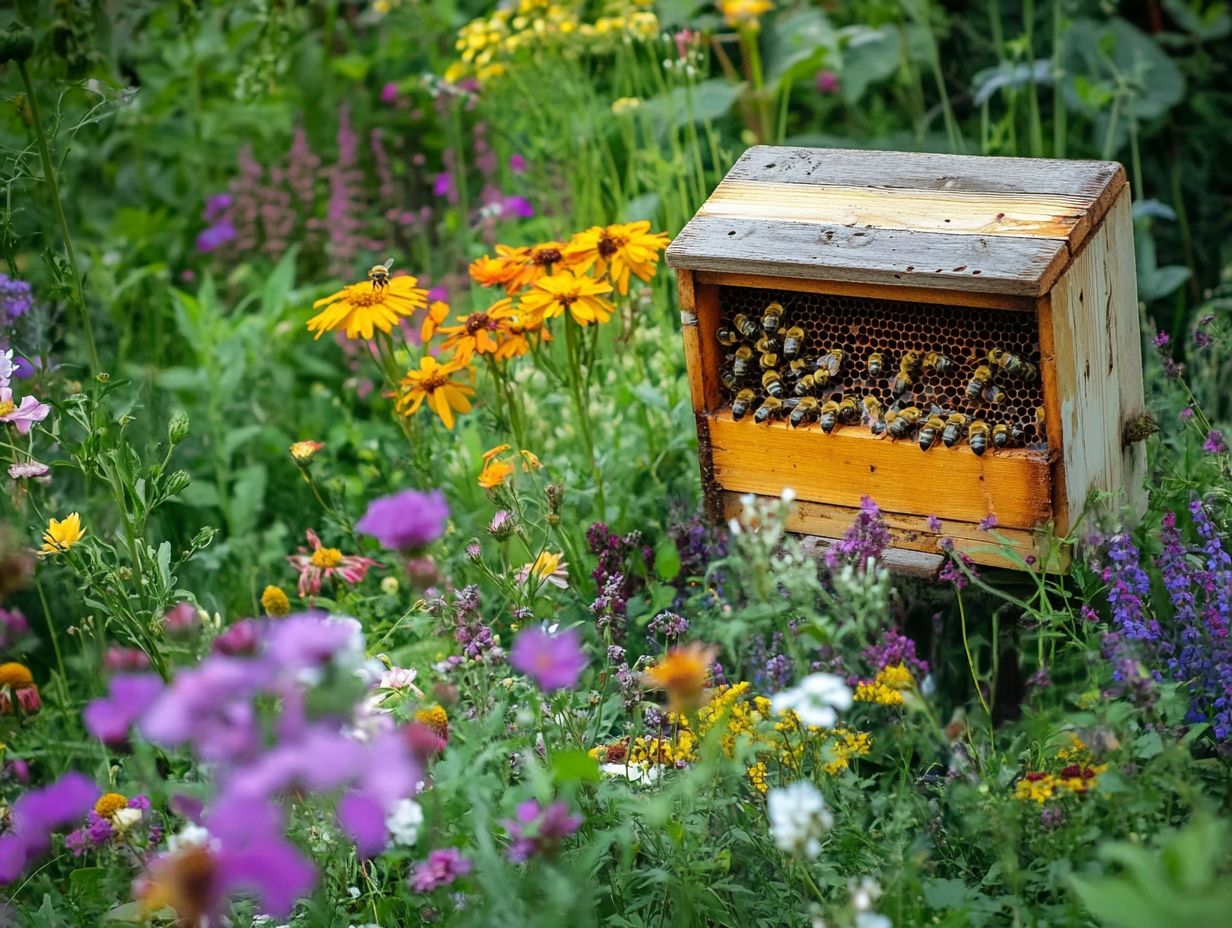
- Diverse hive environments are important for the health and productivity of bee colonies.
- Key factors include plant diversity, climate, hive placement, and the use of natural alternatives to pesticides.
- Signs of a healthy and diverse hive environment include active bees, varied honeycomb colors, and a balanced ecosystem surrounding the hive. The presence of other beneficial insects and pollinators also indicates a thriving environment.
Why is a Diverse Hive Environment Important?
Creating a diverse hive environment is crucial for the health of bee populations, which are important contributors in the world of pollination. This diversity supports the growth of native plants and bolsters the broader ecosystem, contributing significantly to biodiversity.
By fostering a variety of hives, you not only enhance biodiversity but also ensure a consistent supply of food for the bees. This ultimately contributes to the production of honey and other agricultural products. Local beekeepers find this approach beneficial for sustaining high-quality honey yields.
As a local beekeeper, you stand to gain significantly from maintaining these diverse environments, as they lead to greater resilience against pests and create a stable setting where your bees can truly thrive. Implementing DIY pesticide alternatives can further help in protecting your hive without harming the bees or the environment.
What are the Benefits of a Diverse Hive Environment?
The advantages of a diverse hive environment reach far beyond the immediate well-being of bee populations; they cultivate a flourishing ecosystem that supports pollination, enhances biodiversity, and contributes to the production of high-quality organic produce, including fruits and vegetables. When bees find a variety of nectar sources, they produce honey with distinct flavors!
This rich diversity within hives is essential, significantly increasing pollination rates for crops and substantially boosting yields for farmers and gardeners. A vibrant bee community plays a crucial role in sustaining healthy ecosystems by promoting genetic diversity among plant species. Such diversity not only fortifies the resilience of ecosystems but also ensures that various crops can flourish, thereby protecting food security.
Ultimately, by nurturing the health of bee populations through diverse environments, you contribute to benefits that extend beyond the bees themselves, positively impacting the agriculture industry and the environment as a whole.
What Factors Contribute to a Diverse Hive Environment?
Several key factors play a crucial role in creating a diverse hive environment for you. Take into account the availability of various pollen and nectar sources, the diversity of plants in the surrounding area, climate and weather conditions, and the strategic placement of your hives within designated pollinator zones.
A rich array of plants not only supplies essential nutrients for the bees but also enhances their foraging behavior, which refers to how bees search for food. Choosing the best location for your hives greatly influences the bees’ access to these vital resources, fostering a thriving ecosystem.
1. Pollen and Nectar Sources
Pollen and nectar sources are essential for a vibrant hive. They provide the vital nutrients bees need to thrive.
You can plant bee-friendly flowers and native plants to create a landscape that supports bees all season long. Different types of flora bloom at various times of the year, ensuring a continuous supply of resources.
In early spring, crocuses, dandelions, and willows attract hungry bees emerging from winter.
In summer, sunflowers, lavender, and bee balm offer a rich bounty of nectar.
As fall arrives, asters and goldenrods continue to nourish bees as they prepare for colder months. Herbs like thyme and rosemary can also benefit your garden.
By planting a variety of these plants, you enhance your garden s beauty and support pollinators. This diversity is key to maintaining healthy bee colonies and effective pollination.
2. Plant Diversity
Diverse plants create a healthy hive environment. They provide continuous food and shelter for bees and beneficial pollinators.
Using methods like companion planting can increase your garden’s biodiversity. This ensures bees have varied forage throughout the seasons.
When you grow a range of flowering plants with different bloom times, you attract more pollinators. This provides them with year-round resources.
Native plants, having co-evolved with local pollinators, offer the nourishment necessary for their survival.
Adding insect hotels and leaving patches of bare ground for ground-nesting bees enhances your garden’s ecological stability. Embracing biodiversity supports pollinators and creates a more resilient ecosystem.
3. Climate and Weather
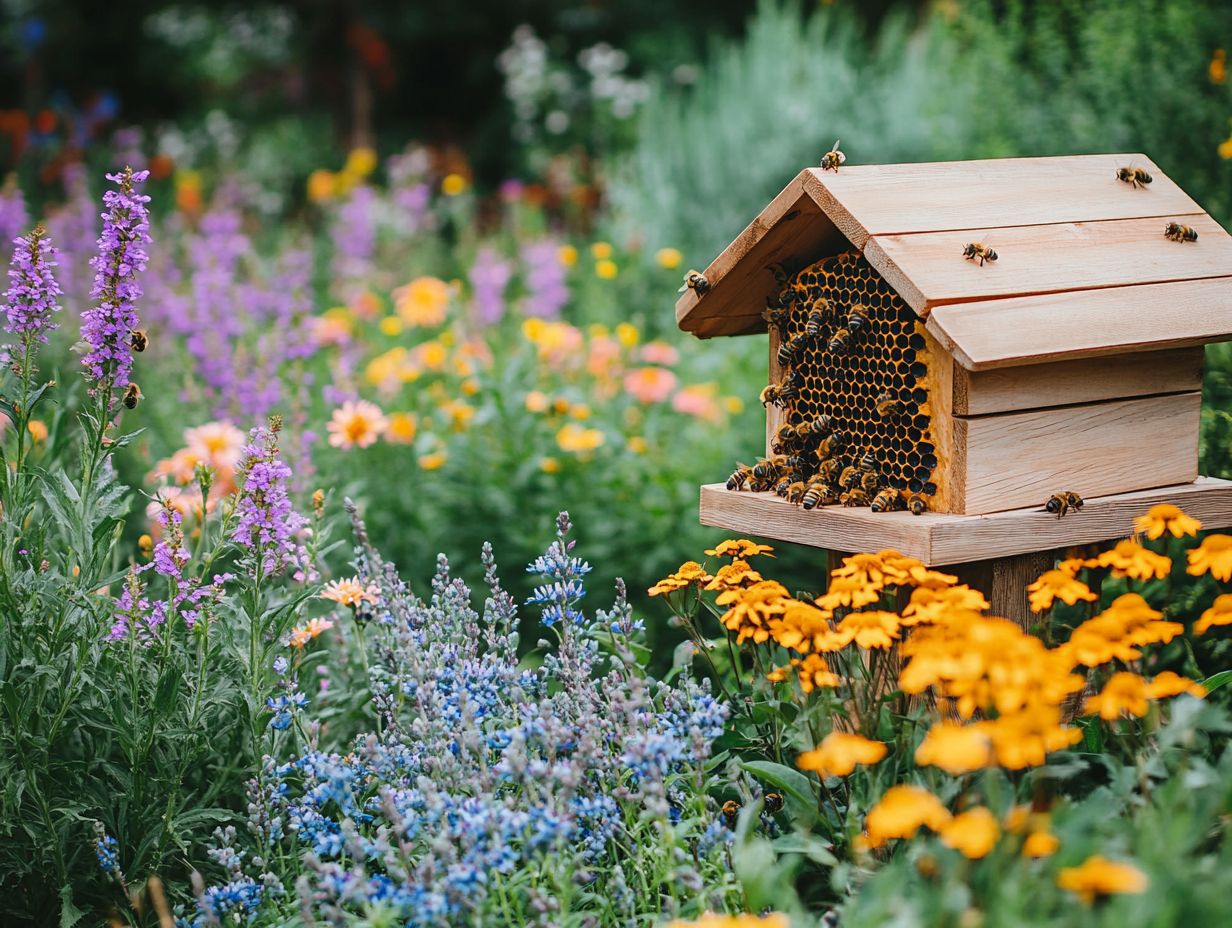
Climate and weather greatly impact the health and diversity of your hive. They affect everything from bee activity to forage availability.
Understanding local climate patterns can help you select optimal hive locations and adopt strategies that lower your environmental impact. This enhances the benefits of your hives.
In cold regions, bee activity may decline significantly. Without proper care, your hive’s food reserves can run low.
In warmer climates, longer foraging periods are beneficial but come with challenges, such as increased resource competition and pests like Varroa mites.
Stay alert to fluctuations in weather patterns. This vigilance helps you adapt practices, ensuring your bees remain healthy and well-fed throughout changing seasons.
4. Hive Location and Placement
The location and placement of your hives are crucial factors in cultivating a thriving hive environment, as they directly influence your bees’ access to forage and water sources. By thoughtfully selecting hive locations within designated pollinator zones, you can significantly enhance your bees’ foraging capabilities and foster a robust hive ecosystem. Establishing a pollinator house nearby can further support bee health.
When choosing a site, it’s essential to check how close flowering plants, trees, and water sources are; these elements provide the vital resources your colony needs to grow and thrive. Consider factors like sun exposure, wind protection, and the risk of pesticide drift, which is the movement of pesticides from where they are applied to other areas and can harm bees. These factors will profoundly affect your bees’ well-being.
Positioning your hives in areas where the surrounding flowers bloom at different times throughout the season ensures a continuous food supply. Regularly monitor the habitat and adjust hive placements based on resource availability to support sustainable foraging patterns and promote the overall health of your colony.
How to Create a Diverse Hive Environment?
Creating a diverse hive environment involves several practical steps that you can implement to support bee populations and enhance local biodiversity. By planting a variety of flowers that offer both nectar and pollen, you play a vital role in fostering a thriving ecosystem. Renowned naturalist David Attenborough emphasizes the importance of such diversity for the environment.
Ensuring a reliable water source is equally important; it s an essential component for maintaining bee health. Additionally, steering clear of harmful pesticides and periodically rotating hive locations can further safeguard these crucial pollinators and promote their well-being. Implementing DIY recipes for natural pest control can also benefit your garden and hive.
1. Plant a Variety of Flowers, Plants, and Herbs
Planting a diverse array of flowers and plants is one of the most effective ways to cultivate a vibrant hive environment, ensuring that bees have continuous access to an abundant and varied food supply. Encouraging employee engagement in these activities can further promote workplace diversity and contribute to environmental sustainability.
To truly maximize these benefits, include specific flower types like lavender, sunflowers, and clover, each blooming at different times throughout the growing season.
For example, lavender, with its striking purple spikes, not only offers nectar during the summer months but also adds a delightful fragrance that enhances your garden’s appeal. Meanwhile, clover, often underestimated, begins blooming in early spring, providing a reliable food source for bees and other pollinators when they need it most. Sunflowers, with their large, cheerful blooms, attract bees from mid-summer to fall, creating a buzzing spectacle in your garden.
By incorporating these plants into your garden, you can create a sanctuary that promotes bee health and resilience, ensuring that these vital pollinators thrive throughout the entire season.
2. Provide a Water Source
Providing a reliable water source is essential for your bees, as they rely on water for hydration, regulating hive temperature, and processing their food. Adding a water feature or a shallow dish filled with pebbles and water to your garden creates an inviting environment that encourages bee foraging and supports their overall health.
Water plays a critical role not just in sustaining individual bees, but also in maintaining the vitality of the hive as a whole. When your bees have access to clean water, they can perform their various tasks more effectively, including caring for larvae and regulating hive temperature to ensure optimal living conditions. This is vital for creating delicious honey and keeping your hive thriving!
You can enhance this ecosystem by incorporating a variety of water sources, like birdbaths with rocks or small fountains that create gentle splashes. These features will attract not only bees but also other beneficial pollinators, fostering a diverse ecosystem in your garden.
Such efforts are crucial for promoting a balanced and thriving hive, ultimately contributing to healthier crop growth and increased biodiversity in the surrounding area. Planting these flowers now will ensure your bees have the food they need as soon as they wake from winter!
3. Avoid Pesticides and Chemicals
Avoiding pesticides and chemicals is essential for safeguarding bee populations and fostering a thriving hive environment. Embracing natural alternatives and crafting DIY pesticides with safe ingredients can significantly diminish the harmful effects on bees while effectively managing garden pests.
Consider practices like growing different plants together to keep pests away, creating a healthier ecosystem in your garden. Attracting beneficial insects, like ladybugs and lacewings, allows you to naturally keep pest populations in check without disrupting bee habitats.
Establishing a diverse array of flowering plants provides a continuous food source for bees and contributes to a balanced garden environment. This integrated approach promotes bee health and enables sustainable pest management without the need for synthetic chemicals. Planting native plants also supports local bee populations.
4. Rotate Hive Locations
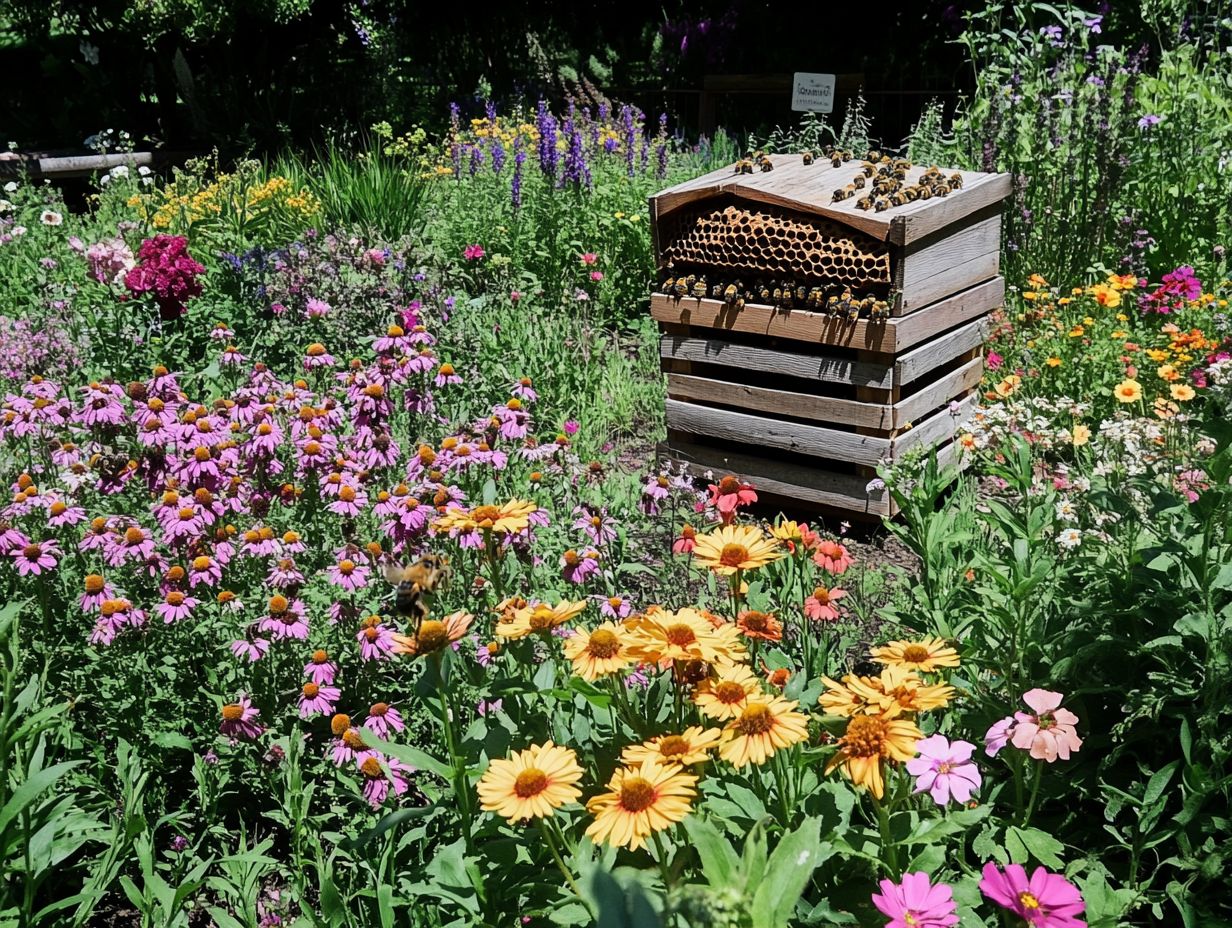
Rotating your hive locations is a highly effective strategy to minimize pests and diseases while ensuring your bees have access to fresh forage. By periodically changing the placement of your hives, you can reduce the environmental footprint and promote a healthier hive ecosystem. This allows your bees to thrive in various areas, ensuring better biodiversity and supporting overall hive health.
This practice increases the availability of diverse pollen sources and disrupts the life cycles of unwelcome pests, like Varroa mites (tiny parasites that feed on bee blood) and small hive beetles, which tend to concentrate in specific locations.
To implement rotating hive locations, engage in careful planning. Understanding seasonal blooming patterns and local pest populations is essential. Scout areas that boast varied flora and minimal pesticide exposure while keeping an eye on local regulations regarding hive placement.
Regular monitoring and meticulous record-keeping are invaluable for assessing the benefits of your strategic relocations. This informed approach will ultimately bolster your hive’s productivity and resilience. Connecting with local beekeepers can also provide insights and share best practices.
What Are the Signs of a Healthy and Diverse Hive Environment?
Recognizing the signs of a healthy and diverse hive environment is crucial for you as a beekeeper to ensure the well-being of your bees. Look for indicators such as:
- Active and productive bees
- A variety of colors and pollen in the honeycomb
- Minimal pest and disease issues
- A balanced ecosystem around your hive
These positive signs reflect a thriving hive, showcasing the care and attention you provide to your buzzing companions.
1. Active and Productive Bees
Active and productive bees are a clear sign of a thriving hive environment, tirelessly foraging for nectar and pollen and playing a crucial role in effective pollination. By observing the activity levels of these bees and their interactions with various flowers, you can gain valuable insights into the overall health of the hive.
A hive bustling with active bees isn t just a delightful sight; it stands as a testament to the favorable environmental conditions that sustain them. Factors like an abundance of flowering plants, suitable weather, and minimal disturbances all contribute to heightened foraging behaviors. When these remarkable insects are fully engaged, they aren t merely collecting resources they re also sharing essential information through their intricate dances, which directly impacts the hive’s productivity. Encouraging native plants and reducing pesticide usage can further support these conditions.
By cultivating a hive that boasts rich biodiversity and ensuring it remains free from pests and diseases, you create an environment where these industrious creatures thrive. This not only enhances the well-being of the bees but also strengthens the vital connection between their behavior and the vitality of the hive itself. Such practices lead to a higher quality of honey production.
2. Varied Color and Pollen in Honeycomb
A rich tapestry of colors and diverse pollen types in honeycomb serves as a strong testament to the vitality of a hive. It showcases the extensive foraging activities carried out by the bees. Each hue often signifies the wide array of plants visited, emphasizing the richness of their food sources and the overall health of the colony.
These vibrant colors are not only beautiful; they are crucial for bee health! This diversity plays a vital role in ensuring a well-rounded diet for the colony, bolstering its resilience against diseases. When bees forage from various floral sources, they gather an impressive blend of nutrients, including essential vitamins and minerals that support their development and immune function.
The distinct types of pollen collected are intricately tied to the bees’ foraging behavior. Certain varieties draw in specific species with their unique scent profiles. Supporting this diversity by planting native plants can be particularly beneficial.
This fascinating interplay between pollen variety and foraging strategies reveals how bees skillfully adapt their behaviors to enhance the hive’s success. It illustrates the complex relationship between the ecosystem and the vibrant life thriving within a honeycomb.
3. Minimal Pest and Disease Issues
The presence of minimal pests and disease issues shows your bees are healthy and thriving in a balanced ecosystem. By fostering biodiversity and cultivating favorable conditions, you can significantly reduce the risk of pest infestations and diseases.
A diverse ecosystem supports a wide range of flora. It provides your bees with abundant nutrition and encourages their natural foraging behaviors. Common pests, such as varroa mites (a type of parasite that affects bees) and greater wax moths, can pose serious threats. Diseases like American foulbrood can wreak havoc on colonies if left unchecked.
Promoting biodiversity by planting various flowering plants and avoiding monoculture farming (the agricultural practice of growing a single crop) can attract beneficial insects that prey on these pests. Healthy hives are better equipped to withstand challenges, as a resilient bee population is less prone to disease and more capable of managing pests naturally.
4. Balanced Ecosystem Surrounding Hive
A balanced ecosystem surrounding your hive is essential for nurturing a diverse and healthy environment. It directly influences the availability of forage and the overall well-being of bee populations. By promoting biodiversity in pollinator zones, you play a crucial role in sustaining this balance.
The relationship between a variety of plants and local bee activity is vital. Different flowers offer essential nectar and pollen sources throughout the seasons, allowing your hives to flourish. You can significantly impact this balance by adopting strategies such as planting native flowering species, creating bee-friendly habitats, and reducing pesticide use to protect these gentle pollinators. Organic produce methods can further support this balance.
Educating your community about the importance of preserving natural landscapes for hive health fosters better practices that lead to thriving bee populations. Every effort you make to support this ecosystem benefits the bees and positively influences agriculture, contributing to a healthier planet overall.
Creating pollinator houses provides shelter and support for bees.
Frequently Asked Questions
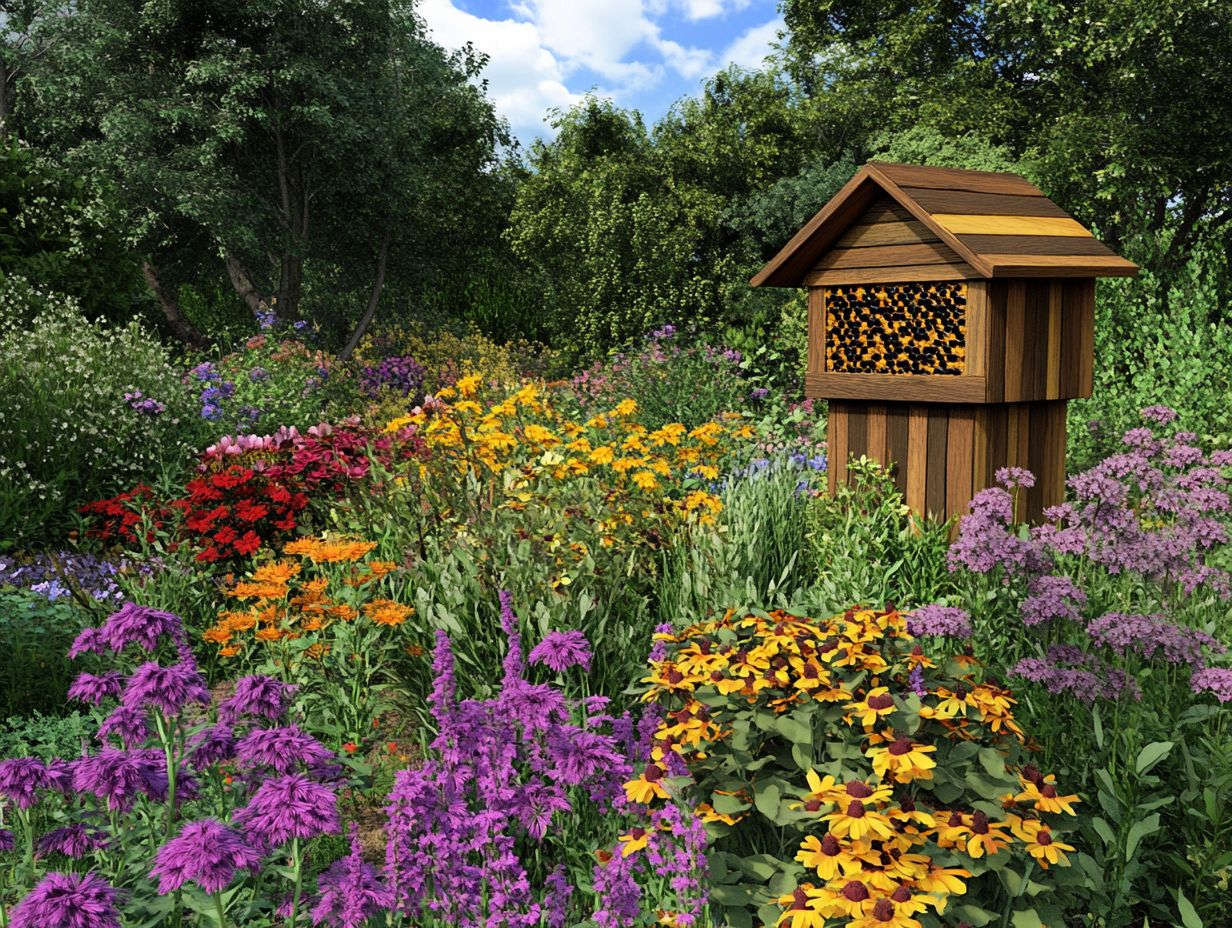
What is a diverse hive environment and its benefits?
A diverse hive environment refers to a beehive that contains a variety of bees from different genetic backgrounds, along with a wide range of resources and habitats for the bees to thrive in, including native plants and water sources.
Why is creating a diverse hive environment important?
A diverse hive environment promotes genetic diversity, helping bees adapt to changes and resist diseases. It enhances pollination efficiency, overall hive health, and contributes positively to biodiversity.
How can I create a diverse hive environment?
To create a diverse hive environment, you can purchase bees from different sources to introduce genetic diversity, plant diverse and pesticide-free flowers for foraging, and provide a variety of habitats such as bee hotels, pollinator houses, and water sources. Incorporating native plants and maintaining a pollinator garden can further support your bees’ diverse foraging needs.
What are some benefits of a diverse hive environment?
You’ll enjoy increased honey production and see stronger, healthier bees. Plus, your bees will help pollinate nearby plants and crops, making your garden flourish!
Are there any challenges to creating a diverse hive environment?
Finding and buying bees from different sources can be challenging. You must also ensure they get along well. Creating diverse habitats and providing enough food and water can be tough too.
What are some tips for maintaining a diverse hive environment?
Regularly check your bees health and behavior. Provide enough resources and introduce different types of bees for diversity. Avoid pesticides and consider natural pest control solutions.

